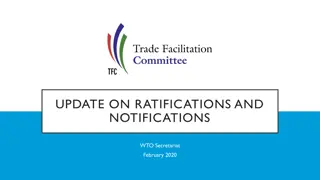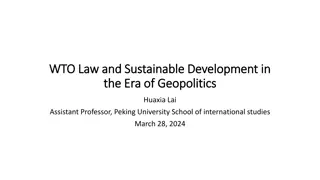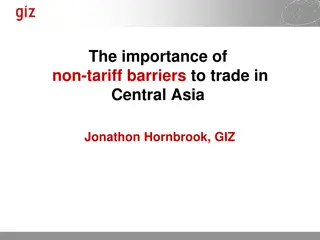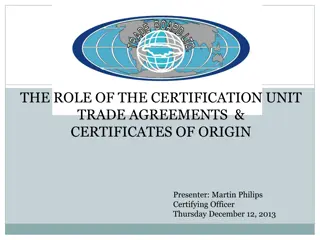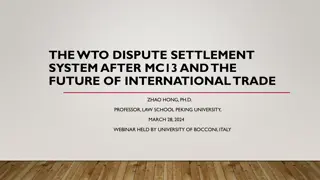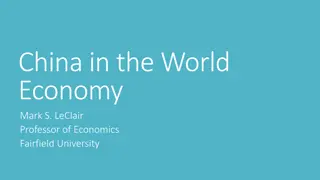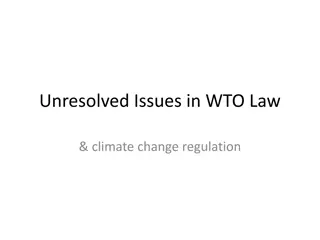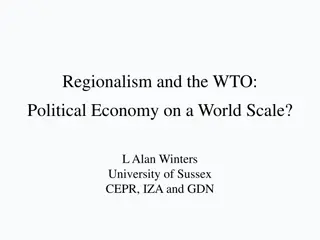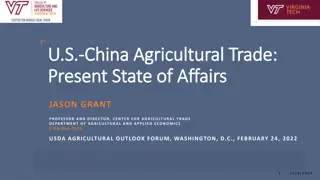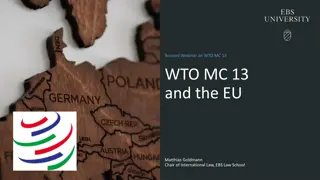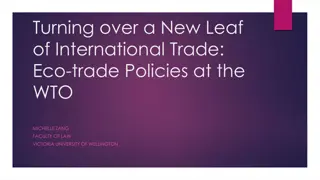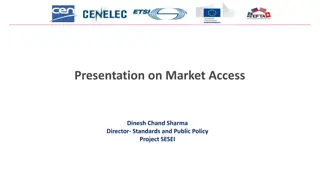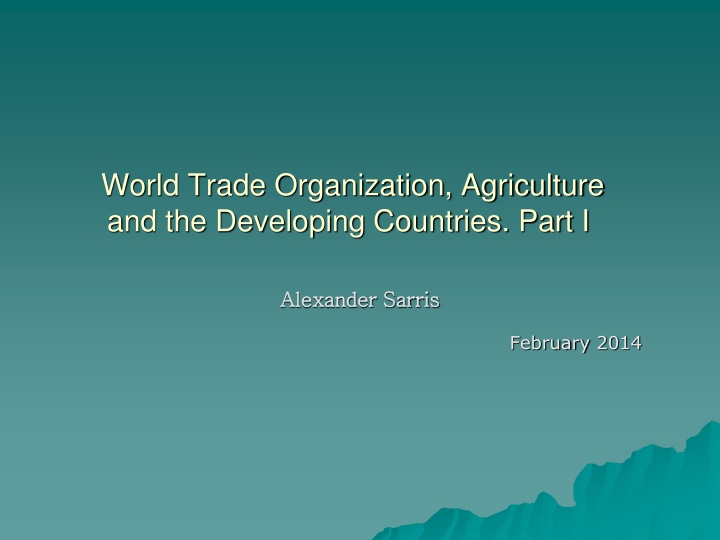
World Trade Organization in Relation to Agriculture and Developing Countries
Explore the role of the World Trade Organization in agriculture for developing nations, including its history, principles, and significance. Learn about the challenges and benefits the WTO presents to developing countries in international trade.
Download Presentation

Please find below an Image/Link to download the presentation.
The content on the website is provided AS IS for your information and personal use only. It may not be sold, licensed, or shared on other websites without obtaining consent from the author. If you encounter any issues during the download, it is possible that the publisher has removed the file from their server.
You are allowed to download the files provided on this website for personal or commercial use, subject to the condition that they are used lawfully. All files are the property of their respective owners.
The content on the website is provided AS IS for your information and personal use only. It may not be sold, licensed, or shared on other websites without obtaining consent from the author.
E N D
Presentation Transcript
World Trade Organization, Agriculture and the Developing Countries. Part I Alexander Sarris Alexander Sarris February 2014
Part I History of agriculture in the WTO The Uruguay Round (UR) agreement What did the Uruguay Round accomplish Developments since the UR The Doha Round The current state of negotiations
General principles of WTO General principles of WTO Non Non- -discrimination (fairness, efficiency) discrimination (fairness, efficiency) Reciprocity (responsibility) Reciprocity (responsibility) Credible dispute settlement (legitimacy) Credible dispute settlement (legitimacy) Transparency Transparency Safeguards when commitments are too burdensome Safeguards when commitments are too burdensome Tariffication Tariffication Decision making by consensus (legitimacy) Decision making by consensus (legitimacy) Reliance on members rather than secretariat for operations Reliance on members rather than secretariat for operations
Importance of GATT/WTO for developing countries Importance of GATT/WTO for developing countries International legitimacy and recognition International legitimacy and recognition Provides commitment mechanism against domestic pressures Provides commitment mechanism against domestic pressures Increases bargaining power versus developed countries Increases bargaining power versus developed countries Participation in international Rules of the Game Participation in international Rules of the Game Problems GATT/WTO creates for developing countries Problems GATT/WTO creates for developing countries Must participate fully or not at all (take it or leave it) Must participate fully or not at all (take it or leave it) Most GATT/WTO rules made before many developing countries Most GATT/WTO rules made before many developing countries acceded hence no sense of ownership or GATT/WTO rules acceded hence no sense of ownership or GATT/WTO rules Cost of implementation and participation high Cost of implementation and participation high Lack of analytical capacity to evaluate options and implications of Lack of analytical capacity to evaluate options and implications of commitments commitments
Not all developing countries are WTO members Not all developing countries are WTO members Developing Country Groupings and WTO membership Developing Country Groupings and WTO membership 182 Group WTO members 100 86 53 49 45 30 30 25 22 22 16 DC LIFDC LDC SIDS LLDC NFIDC DC DC Developing Countries Developing Countries LIFDC LIFDC Low Income, Food Deficit Countries Low Income, Food Deficit Countries LDC LDC Least Developed Countries Least Developed Countries SIDS SIDS Small Island Developing States Small Island Developing States LLDC LLDC Land Land- -Locked Developing Countries Locked Developing Countries NFIDC NFIDC Net Food Net Food- -Importing Developing Countries Importing Developing Countries
Agriculture in the GATT before the UR the first four Rounds simply ignored agriculture Dillon Round (1960-1962) Kennedy Round (1963-1967) Tokyo Round (1973-1979) modest concessions in agriculture agriculture left out from GATT WHY?
Agriculture different than other sectors Declining terms of trade Market instability Adjustment in course of development From taxation to support
Real agricultural commodity prices have declined in past 40 years. Less so in the 1990s Real prices of.... 400.00 350.00 300.00 CEXPWLD 250.00 OIXPWLD MTXPWLD DRXPWLD 200.00 SUXPWLD HTXPWLD 150.00 TBXPWLD RMXPWLD 100.00 50.00 0.00 1961 1963 1965 1967 1969 1971 1973 1975 1977 1979 1981 1983 1985 1987 1989 1991 1993 1995 1997 1999 2001
Real prices of bulk food commodities have tended to decrease but since mid 1980s tendency seems to have stopped Real Prices: Bulk Commodities (1957-2008) 1400 1200 Wheat Rice Maize Soybeans 1000 800 600 400 200 0 1957 1960 1963 1966 1969 1972 1975 1978 1981 1984 1987 1990 1993 1996 1999 2002 2005 2008
Real prices of vegetable oils have tended to decrease but since mid 1980s tendency seems to have stopped Real Prices: Vegetable Oils (1957-2008) 2500 2000 1500 1000 500 Palm Oil Soybean Oil Rapeseed Oil 0 1957 1960 1963 1966 1969 1972 1975 1978 1981 1984 1987 1990 1993 1996 1999 2002 2005 2008
Real prices of livestock commodities have tended to decrease albeit at slowing pace since mid 1980s Real Prices: Livestock Commodities (1957-2008) 300 Butter Pigmeat Beef Poultry 250 200 150 100 50 0 1957 1960 1963 1966 1969 1972 1975 1978 1981 1984 1987 1990 1993 1996 1999 2002 2005 2008
Real prices of sugar and beverages have tended to decrease but since mid 1980s tendency seems to have stopped Real Prices: Sugar & Beverages (1957-2008) 1800 Coffee Sugar Tea Cocoa 1600 1400 1200 1000 800 600 400 200 0 1957 1960 1963 1966 1969 1972 1975 1978 1981 1984 1987 1990 1993 1996 1999 2002 2005 2008
Historic volatilities of international prices seem to increase with price spikes for grains Wheat 600 500 400 volatility nominal prices 300 200 100 0 1957 1962 1967 1972 1977 1982 1987 1992 1997 2002 2007 Maize 400 350 300 250 volatility nominal prices 200 150 100 50 0 1957 1962 1967 1972 1977 1982 1987 1992 1997 2002 2007
Historic volatilities of international prices seem to increase with price spikes for rice and soybeans Rice 600 500 400 volatility nominal prices 300 200 100 0 1957 1962 1967 1972 1977 1982 1987 1992 1997 2002 2007 Soybeans 800 700 600 500 volatility nominal prices 400 300 200 100 0 1957 1962 1967 1972 1977 1982 1987 1992 1997 2002 2007
Historic volatilities of international prices seem not to follow price trends for meats Pig Meat 700 600 500 400 volatility nominal prices 300 200 100 0 1980 1985 1990 1995 2000 2005 Poultry 180 160 140 120 100 volatility nominal prices 80 60 40 20 0 1980 1985 1990 1995 2000 2005 Beef 400 350 300 250 volatility nominal prices 200 150 100 50 0 1957 1962 1967 1972 1977 1982 1987 1992 1997 2002 2007
Historic volatilities of international prices seem to increase with price spikes for tropical beverages and sugar Cocoa 450 400 350 300 250 volatility nominal prices 200 150 100 50 0 1957 1962 1967 1972 1977 1982 1987 1992 1997 2002 2007 Coffee 900 800 700 600 500 volatility nominal prices 400 300 200 100 0 1964 1969 1974 1979 1984 1989 1994 1999 2004 Sugar 700 600 500 400 volatility nominal prices 300 200 100 0 1957 1962 1967 1972 1977 1982 1987 1992 1997 2002 2007
Historic volatilities of spot prices in organized markets (CBOT) seem to be increasing over time Historic yearly volatility Wheat, Corn and Rice 35 30 25 Wheat Corn Rice 20 Average 15 10 5 0 1988 1989 1990 1991 1992 1993 1994 1995 1996 1997 1998 1999 2000 2001 2002 2003 2004 2005 2006 2007 Historic yearly volatility Soybeans, Soyoil and Soymeal 35 30 25 Soybeans Soyoil Soymeal 20 Average 15 10 5 0 1988 1989 1990 1991 1992 1993 1994 1995 1996 1997 1998 1999 2000 2001 2002 2003 2004 2005 2006 2007
How have agricultural policies in developed countries evolved? In US low prices in the 1920s and 1930s led to market support policies When secular terms of trade kept declining, nominal prices did not follow In EU post world-war II CAP motivated by desire for European food security (!!!) interpreted as food self sufficiency CAP designed to ensure food self sufficiency, community preference, and support for small rural producers In Japan major issue to support rural small producers In Australia, Canada issue to ensure international competitiveness
The Uruguay Round Uruguay Round (1986-1994) agriculture on the center stage of the negotiations 20 September 1986 the declaration of Punta del Este (Uruguay) agreement to negotiate in order to achieve greater liberalization of trade in agriculture by bringing both border and domestic policies under strengthened GATT rules and disciplines The Round expected to be concluded by 31 December 1990 (to last 4 years)
the negotiations on agriculture in the Uruguay Round the lights/boxes approach to policy classification the red box contains policy instruments which cannot be used the green box contains policy instruments which do not distort trade, or have minimal trade distorting effects, and will not be subject to reduction commitments the amber box contains policy instruments which distort trade and will be subject to reduction commitments
the negotiations on agriculture in the Uruguay Round October 1990 US final proposal - export subsidies to be reduced by 90% over 10 years - non-tariff barriers converted in tariffs and all tariffs to be reduced by 75% over 10 years - domestic support in the amber box to be reduced, on a product by product basis, by 75% over 10 years November 1990 EC final proposal -aggregate domestic support in the amber box to be reduced by 30% - no specific commitment on export subsidies - relatively vague proposal on market access
the negotiations on agriculture in the Uruguay Round (May 1992) MacSharry reform of the EC Cap reduction in (coupled) market price support introduction of partially decoupled direct payments the reform makes it possible for the EC to accept some of the requests made at the negotiations table
the negotiations on agriculture in the Uruguay Round 20 November 1992 the Blair house agreement bilateral (!) US-EC agreement turning point for the negotiation on agriculture a final draft (amending the Dunkel text ): EC partially decoupled direct payments and US deficiency payments not to be subject to reduction commitments (the blue box ) reduction in trade distorting domestic support based on an aggregate measure ( not product by product) export subsidies to be reduced by 21% (instead of 24%) peace clause (truce clause?)
the negotiations on agriculture in the Uruguay Round 15 December 1993 the agreement is reached! the modalities, then the schedules 15 April 1994 the UR Agreement is signed in Marrakech the Agreement on agriculture is one of the fifteen agreements [the Sanitary and Phyto-Sanitary (SPS) agreement] [a new dispute settlement procedure (from consensus to a judicial system )]
the Agreement on agriculture 3 main areas of commitments domestic support market access export competition six year implementation period (1995- 2001)
What the UR achieved in agriculture a rules-based system that largely reduces arbitrary actions: NTBs tariffied and reduced + minimum access to ensure trade takes place commitment to reduce some types of distortive dom. support commitment to reduce exp subsidies recognised need for SDT for dev g countries (time, size of cuts, special exemptions, trade-related TA, etc.) also, new disciplines under SPS Agr, to minimize discriminatory trade effects of SPS Overall, a major accomplishment, considering where we were!
What UR did not achieve in agriculture brought agriculture formally into the WTO but also legitimatised remaining distortions Members that established the right to certain distorting policies were essentially protected by the system against challenges very high tariffs, Tariff peaks & Tariff Escalation remain large trade distorting support (AMS) and vague disciplines on what constitutes non-trade distorting support (Green Box) large exp subsidies and other means of subsidization effectively, very little additional market access plenty of room for circumventing commitments in all areas highly uneven playing field between those that had the right & the means to take advantage of flexibility and those that did not have either
Differing perceptions of the UR outcome not accidental that agr was outside the GATT for 40 yrs and that UR took 7.5 yrs to be negotiated. several countries consider agr not just another sector of the economy. Others wish to see agr fully integrated into the MTS the first, those protecting agr (mostly dev d ) consider that bringing agr into the MTS was a major concession for them not prepared to move quickly on further reform the second, with competitive agr (both dev d and dev g) consider that AoA achieved little real reform overall message here is that perceptions about agr liberalization and the UR outcome were, and continue to be, wide apart
Implementation of the UR Not much real reduction in support in developed countries Income terms of trade have evolved differently for developed and developing countries
the implementation domestic support commitments have not been a problem for hardly any country 1. because of the much lower price support with respect to 1986-88 2. because of the blue box
Farm Support in OECD Countries (US$ 280 billion in 2004) 70 Japan 60 50 EU 40 %PSE 30 OECD 20 USA 10 0 1986 1988 1990 1992 1994 1996 1998 2000 2002 2004p
Producer Price Protection 2.6 Japan 2.2 NPCp 1.8 EU 1.4 OECD USA 1.0 1986 1988 1990 1992 1994 1996 1998 2000 2002 2004p
EU has kept commitments but not much reduction in domestic support European Union. Domestic support reduction commitments: notified AMS, support falling in the "blue box" and margin left with respect to the maximum allowed AMS. (1995/96 - 2000/01) (bill Euro) 100 80 60 40 20 0 95/96 96/97 97/98 AMS 98/99 Blue box 99/00 Margin 00/01. 01/02.
US has also met its commitments, while increasing total domestic support U.S. . Domestic support reduction commitments: notified AMS and support exempt from reduction commitments ("de minimis" and "green" box) (1999 and 2000: estimates). (Bill $) 35 WTO commitment 30 25 20 15 10 5 0 1995 1996 1997 1998 1999 2000 AMS "de minimis" other exempt support
market access commitments tariffication of many non-tariff barriers 36% (unweighted average) tariff reduction in six years
the implementation market access commitments resulted in a limited reduction of border protection 1. because of the market reorientation of prices in many countries ( water in the tariffs ) 2. because of the dirty tariffication but most TRQs have been effective, although issues related with the implementation mechanisms
Average-cut routine Tariff 1 Tariff 2 % 1 % Initial 1400 Final 0 1400 Cut 100 0
Average-cut routine (2) Countries with highly variable tariffs have important peaks These can be cut by minimal levels, leaving much of the protective effect, and the variance of tariffs variance may even be increased Countries with uniform bindings must bring about a cut in average tariffs
Features of tariff distributions Wtd average Binding overhang % of bound 43 18 60 24 59 CV Bound at zero % Applied % 14 17 21 5 24 Bound % 25 21 52 7 60 % Ind. countries Europe Japan USA Developing 246 168 282 203 137 29 25 29 28 1
Developing countries made considerable concessions in the Uruguay Round Developing countries made considerable concessions in the Uruguay Round Uruguay Round Tariff Concessions Given and Received Uruguay Round Tariff Concessions Given and Received Bindings (percentage of 1989 imports) Tariff reductions Pre-UR Post- % of imp orts Depth of UR cut (dT/( 1+T) Tariff concessions given Tariff concessions given- -All merchandise All merchandise Developed Economies 80 89 30 1.0 Developing Economies 30 81 29 2.3 Tariff concessions received Tariff concessions received- -All Merchandise All Merchandise Developed Economies 77 91 36 1.4 Developing Economies 64 78 28 1.0 Source: Finger and Schuknecht (1999) 1. 1.Developing Developing country country cuts 2. 2.Developing Developing country country tariff 3. 3.Concessions Concessions received received by cuts covered covered the tariff cuts cuts were by developing developing countries the same same percentage percentage of were deeper deeper countries were of imports imports as as developed developed ones ones were smaller smaller
Agricultural Products: Uruguay Round Tariff Bindings Percent of imports GATT-bound Post UR bindings that reduce protection Pre-UR Post-UR Tariffied and untariffied products Developed Economies 72 100 26 Developing Economies 37 100 17 Source: Finger Ingco and Reincke (1996)
World production shares 1980-2002 1980 1990 2002 Cereals Developed Countries 0.51 0.46 0.42 Least Developed Countrs 0.05 0.05 0.06 (Dev -LDC) 0.44 0.49 0.52 Meat, total Developed Countries 0.66 0.58 0.43 Least Developed Countrs 0.03 0.03 0.03 (Dev -LDC) Developed Countries 0.32 0.76 0.40 0.70 0.54 0.59 Milk, total Least Developed Countrs (Dev -LDC) 0.03 0.22 0.03 0.27 0.03 0.38 Oilcrops, primary Developed Countries Least Developed Countrs 0.42 0.05 0.35 0.04 0.29 0.03 (Dev -LDC) 0.52 0.61 0.68 Sugar (centrif) Developed Countries 0.45 0.40 0.29 Least Developed Countrs 0.02 0.02 0.02 (Dev -LDC) 0.54 0.58 0.69
World production shares 1980-2002 (contd) 1980 0.46 1990 0.32 2002 0.28 Citrus fruit, total Developed Countries Least Developed Countrs (Dev -LDC) Developed Countries Least Developed Countrs (Dev -LDC) 0.02 0.53 0.02 0.02 0.67 0.02 0.02 0.70 0.02 Bananas 0.12 0.86 0.11 0.87 0.08 0.90 Tropical beverages Developed Countries Least Developed Countrs (Dev -LDC) Developed LDC Developing except LDC 0.03 0.02 0.01 0.10 0.87 0.34 0.09 0.57 0.09 0.89 0.30 0.07 0.63 0.07 0.92 0.28 0.08 0.64 Fibre crops
World export shares 1980-2002 1980 0.87 0.00 0.12 0.83 0.00 0.17 0.98 0.00 0.02 0.75 0.01 0.23 0.35 0.01 0.64 1990 0.86 0.00 0.13 0.82 0.00 0.18 0.97 0.00 0.03 0.57 0.01 0.42 0.41 0.01 0.58 2002 0.77 0.00 0.23 0.77 0.00 0.23 0.93 0.00 0.07 0.52 0.01 0.47 0.35 0.01 0.64 Cereals Developed Countries Least Developed Countrs Developing except LDCs Developed Countries Least Developed Countrs Developing except LDCs Developed Countries Least Developed Countrs Developing except LDCs Developed Countries Least Developed Countrs Developing except LDCs Developed Countries Least Developed Countrs Developing except LDCs Meat, total Milk, total Oilcrops, primary Sugar (centrif)
World export shares 1980-2002 (contd) 1980 0.67 1990 0.66 2002 0.68 Citrus fruit, total Developed Countries Least Developed Countrs 0.00 0.00 0.00 Developing except LDCs Developed Countries Least Developed Countrs 0.33 0.04 0.33 0.04 0.31 0.15 Bananas 0.01 0.01 0.00 Developing except LDCs 0.95 0.95 0.85 Tropical beverages Developed Countries Least Developed Countrs 0.05 0.04 0.08 0.13 0.09 0.06 Developing except LDCs Developed Countries Least Developed Countrs 0.83 0.50 0.86 0.49 0.86 0.68 Fibre crops 0.16 0.15 0.14 Developing except LDCs 0.34 0.37 0.18
from Marrakech to Doha art. 20 of the 1994 UR Agreement on Agriculture: commitment to start a new negotiation on agriculture by the end of 1999 Seattle (Nov 30 - Dec 3, 1999) Failure! early in 2000 only negotiations on agriculture and services started, but nothing really happened until the Ministerial in Doha (November 2001)

